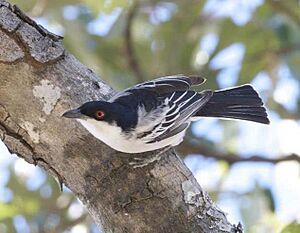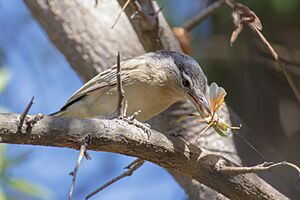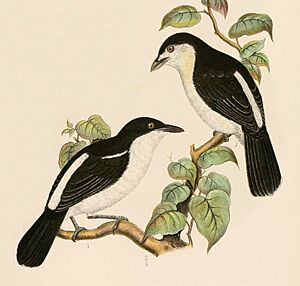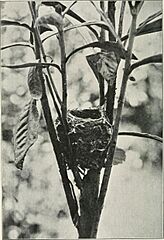Black-backed puffback facts for kids
Quick facts for kids Black-backed puffback |
|
|---|---|
 |
|
 |
|
| male and female, D. c. okavangensis | |
| Conservation status | |
| Scientific classification | |
| Genus: |
Dryoscopus
|
| Species: |
cubla
|
The black-backed puffback (Dryoscopus cubla) is a small, active bird found in Africa. It belongs to the shrike family. These birds are common in many wooded areas south of the equator. They usually stay in one place and don't migrate far.
You can often see them moving around in tree canopies, either alone, in pairs, or with their families. Male puffbacks are famous for their special display. They puff out the loose feathers on their lower back and rump, making themselves look like a fluffy ball! They also make many different sounds, like whistles, clicks, and rasping noises. The name cubla comes from an old southern African word that sounds like a click.
Contents
What Does It Look Like?
Black-backed puffbacks are about 17 cm (about 6.7 inches) long. Males and females look similar but have small differences.
Male Birds
Adult males have shiny, deep blue-black feathers on their upper body. They have a black cap on their head and bright red eyes. Their undersides are pure white.
Female Birds
Females have a black stripe near their eye and white feathers above it. Their ear feathers are pale, and their crown (top of the head) is not completely black. Their backs are usually greyer than the males', and their white feathers might have grey or buffy (light brownish-yellow) hints.
Young Birds
Young puffbacks look like females. However, they have brownish beaks and eyes. Their upper parts and sides are even greyer, and their undersides and wing feather edges are more buffy.
You can tell the black-backed puffback apart from other puffback species by its size, eye color, wing markings, and the way the female looks.
Where Do They Live?
Black-backed puffbacks live mainly in sub-Saharan Africa, south of the equator. Their range stretches from southern Somalia all the way down to coastal South Africa. North of the equator, a slightly larger bird called the northern puffback takes its place. These two species are very closely related.
Their Homes
You can often find these birds in many different places, such as:
- Gardens
- Thick bushes near rivers
- Mangrove forests
- Woodlands
- Moist or dry savanna (grasslands with scattered trees)
- Bushveld (a type of woodland)
- The edges of afromontane forests (mountain forests in Africa)
They live from sea level up to about 2,200 meters (about 7,200 feet) high. They are the only puffback species in most of their range. They are most common in dense woodlands, but they use all kinds of woodland, even tree plantations. In southern Africa, they are often found in miombo woodlands, mopane woodlands, and forests along rivers, like those in the Okavango Delta.
Black-backed puffbacks avoid very dry areas with thorny acacia trees. They also don't usually go into the deep parts of afromontane forests or the Congo Basin.
What Are Their Habits?
Black-backed puffbacks usually live in pairs. They are very active and move around in the higher parts of trees. Sometimes, they join flocks with other bird species.
Display and Calls
When a male wants to display, he flies around and calls loudly. He puffs out the long, loose white feathers on his lower back, making himself look much bigger. During this display flight, the male might make a "chow-chow-chow..." sound or a "tik-weeu, tik-weeu..." call. The male might also make a click sound followed by a sharp "whiplash" sound. The female might reply with a soft "ssssshh ssssshh" sound.
What Do They Eat?
Their diet mainly consists of many caterpillars. They also eat beetles, ants, termites, and small fruits. These birds usually stay in the same area and don't travel far.
Who Are Their Neighbors?
Black-backed puffbacks can become food for other animals. For example, the African goshawk hunts them. Their nests and eggs can be eaten by the grey-headed bushshrike. Sometimes, ants can kill them, or other territorial shrikes, like boubou shrikes, might attack them.
They can also be affected by brood parasites. This means other birds, like the black cuckoo and emerald cuckoo, might lay their eggs in the puffback's nest. The puffback parents then raise the cuckoo chicks, sometimes without knowing.
How Do They Breed?
Black-backed puffbacks are monogamous, meaning they have only one partner at a time. They usually raise one brood (set of chicks) per breeding season.
Building the Nest
The female builds the nest, which takes about 11 days. The male stays with her, calling and displaying often. The nest is a neat, cup-shaped structure made of bark strips. These strips are held together and attached to the tree branches with lots of spider webs. The nest is usually placed in a fork of a tree branch, high up in the canopy, especially in trees with smooth, grey bark that matches the nest.
Eggs and Chicks
The female lays two to three eggs, usually one every day. She then incubates (sits on) the eggs for 13 to 14 days. The eggs are speckled, sometimes with a ring of speckles around the wider end. Both parents help to raise the chicks. The young birds leave the nest after about 18 days.
When Do They Breed?
In southern Africa, breeding usually happens during the summer months. In tropical areas, it can be less predictable. In the moist eastern parts of southern Africa, breeding starts earlier (October to December). In Zimbabwe, it's mostly in spring (September to November), but they can breed in most months. In the Transvaal region, the peak breeding time is a bit later (September to January).
Different Types of Puffbacks
There are five recognized types, or "races," of the black-backed puffback. These types look slightly different depending on where they live. Scientists tell them apart by things like their size, how white the male's feathers are, the color of the female's upper parts, if they have a dark spot near their eye, and how much white is on their wings.
Here are some of the main types:
- D. c. affinis: Found along the coast from Somalia to Tanzania. Both males and females don't have white edges on their wing feathers.
- D. c. nairobiensis: Found on the plateau east of Kenya's Rift Valley.
- D. c. hamatus: Lives in tropical lowlands. Males have pure white lower backs, rumps, and undersides. Their eyes are red.
- D. c. okavangensis: Found inland in southern Africa. Their undersides are off-white, and their lower back and rump can be greyish. Their eyes are red.
- D. c. cubla: Found in mountain forests and coastal areas of South Africa. Their lower back, rump, and undersides are distinctly greyish, but their belly is white. Their eyes are orange.
Gallery







